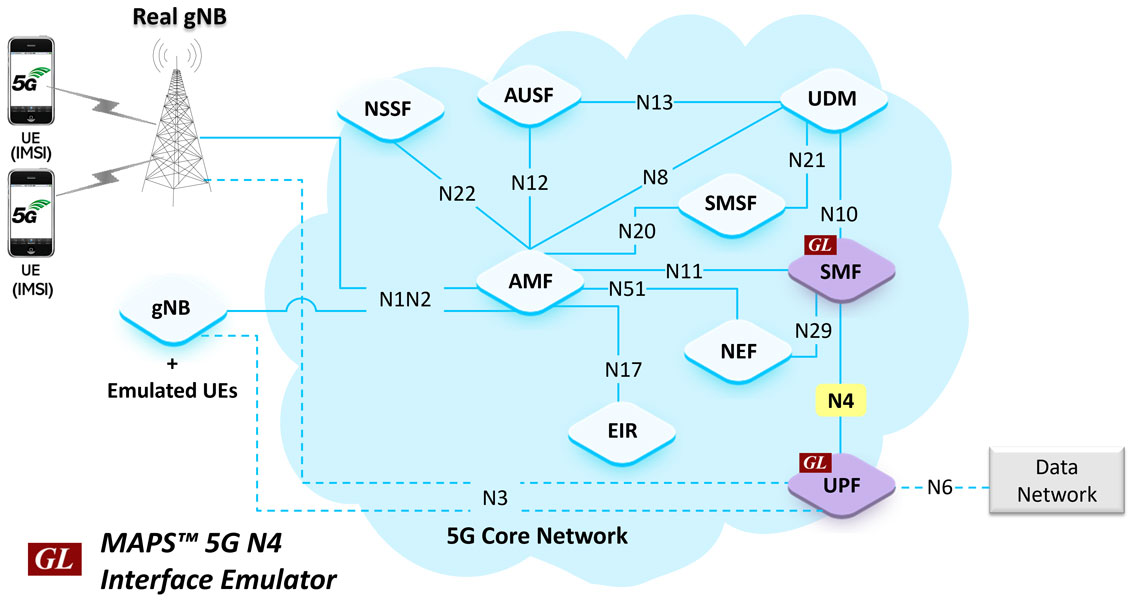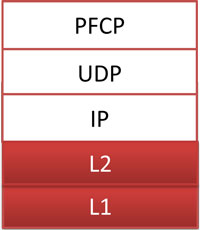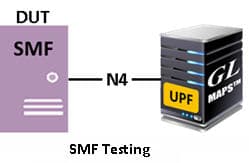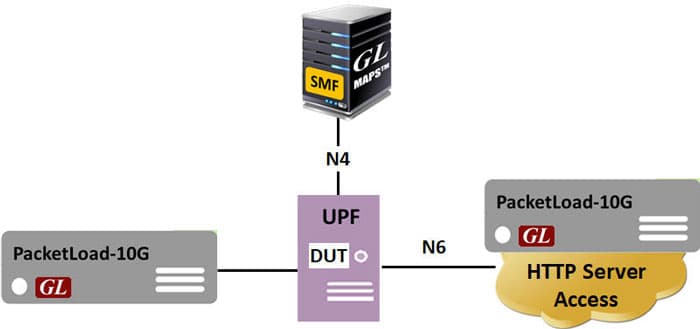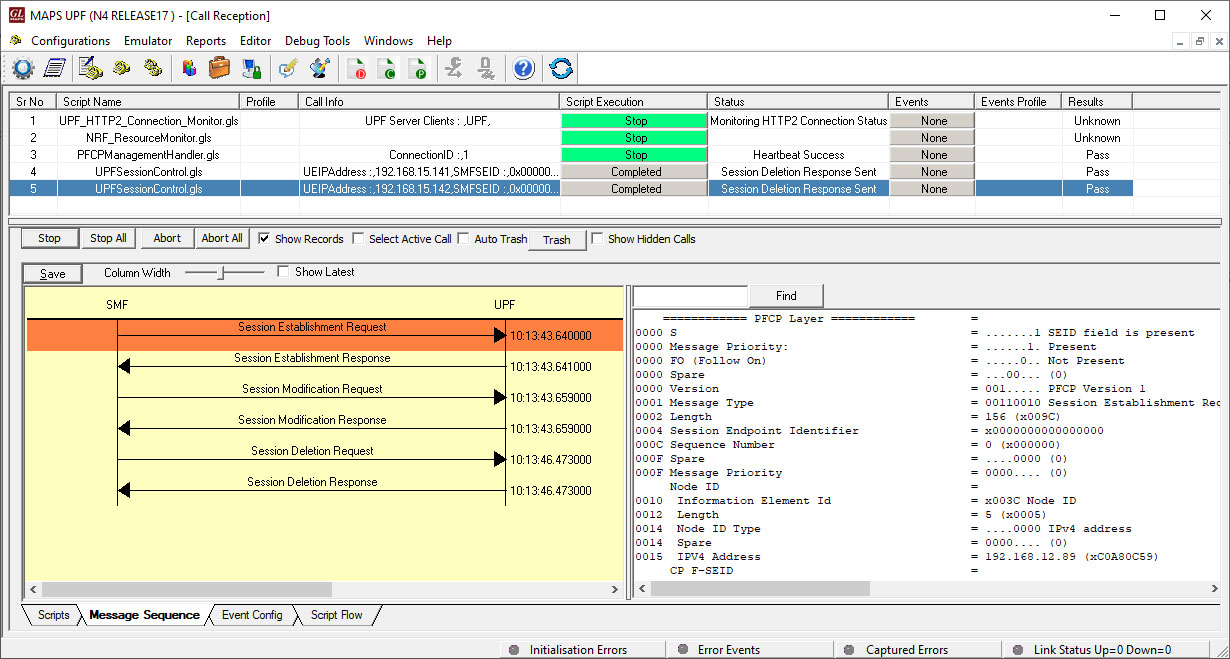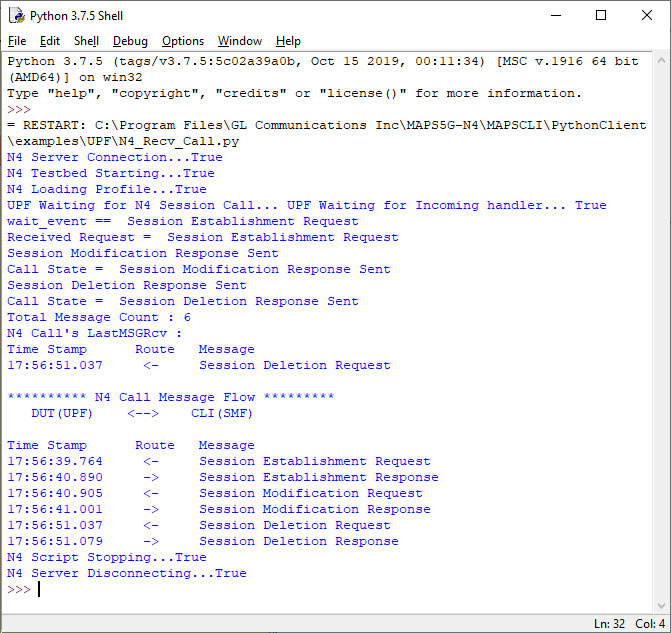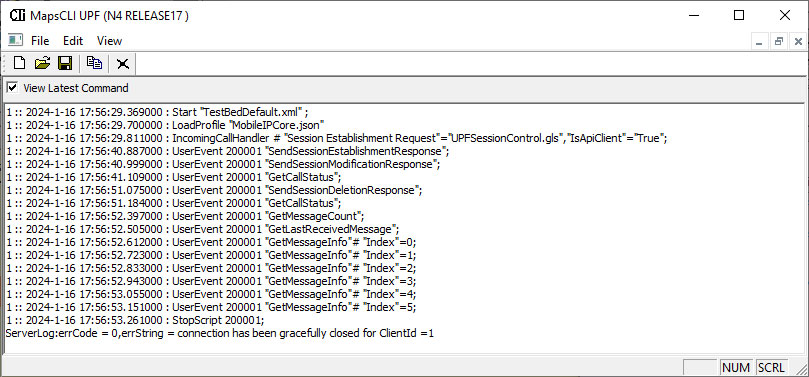5G N4 Interface Emulation
MAPS™ 5G N4 can emulate and test Session Management Function (SMF) and User Plane Function (UPF) elements. SMF in the 5G N4 interface is primarily concerned with managing the UE’s PDU sessions.
Request a Demo / Quote BrochureOverview
GL’s Message Automation & Protocol Simulation (MAPS™) 5G N4 Interface Emulator can emulate PFCP messages and signaling specification as defined by 3GPP standards (Release 17). As seen in the network diagram, N4 is the reference point in the control and user plane separation (CUPS) architecture.
The PFCP is found on the N4 reference point between SMF and UPF (User Plane Function). SMF carries the policy rules attained from the PCF regarding packet handling, forwarding, and usage reporting to the UPF, also implements CUPS in 5G core networks, providing control plane tunnel management and user plane Protocol Data Unit (PDU) sessions.
MAPS™ 5G N4 can emulate and test SMF and UPF elements. SMF in the 5G N4 interface is primarily concerned with managing the UE’s PDU sessions. Its responsibilities include the establishment, modification, and release of the PDU sessions. UPF in the CUPS architecture is responsible for handling user data and reporting the traffic usage data to the SMF.
The CP function controls the packet processing in the UP function by establishing, modifying or deleting PFCP Session contexts and by provisioning rules in UPF regarding packet handling, forwarding, and usage reporting.
At the N4 interface level procedures SMF and UPF nodes are used to manage and establish the items that are not related to a specific N4 session.
Besides emulating network elements SMF and UPF, the emulator also supports error tracking, regression testing, conformance testing, load testing/call generation. It can run pre-defined test scenarios against 5G interface test objects in a controlled & deterministic manner.
MAPS™ 5G N4 Interface Emulator supports powerful utilities like Message Editor, Script Editor, and Profile Editor which allow new scenarios to be created or existing scenarios to be modified using messages and parameters.
GL’s MAPS™ 5G N4 also supports user-plane packet transmission and reception with the purchase of Mobile Traffic Core - GTP (ETH101) licenses and supports simulation of user-plane Gateway traffic in 5G and LTE network with purchase of Mobile Traffic Core – Gateway (ETH102) licenses.
5G N4 Testing Features
- Emulates 5G Core network functions - SMF and UPF
- Supports 5G Control plane and User plane
- Supported Traffic types include Mobile Traffic, and Packet Traffic
- Generates and process PFCP (valid and invalid) messages
- Supports customization of call flow and message templates using Script and Message Editor
- Ready-to-use scripts for quick testing
- Supports scripted call generation and automated call reception
- Supports GTP Traffic (GTP User Plane Data), HTTP traffic generation capability
- Provides Call Statistics and Events Status
- Supports Command Line Interface (CLI) through a client-server model, enabling users to control all features via Python APIs
- Automation, Remote access, and Schedulers to run tests 24/7
Supported Protocols Standards
PFCP |
3GPP TS 23.501 (Release 17) |
UDP |
IETF RFC 768 |
IPv4 |
IETF RFC 791 [5] |
IPv6 |
IETF RFC 2460 [6] |
Use Cases
5G N4 Interface Procedure
In 5G N4 interface, MAPS™ acts as either SMF to test UPF or UPF to test SMF emulating the following call control procedure.
- MAPS™ N4 Emulator supported Procedures are -PFCP Session Establishment Procedure, PFCP Session Modification Procedure, and PFCP Session Deletion Procedure.
Node Related Procedures:
- PFCP Heartbeat
- PFCP Association Setup
- PFCP Association Update
- PFCP Association Release
- PFCP Version Not Supported
- PFCP Node Report
PFCP Session related messages:
- PFCP Session Establishment
- PFCP Session Modification
- PFCP Session Deletion
- PFCP Session Report
The below screenshots depicts the Call Control Procedure simulation across 5G N4 interface between SMF and UPF.
CLI/API
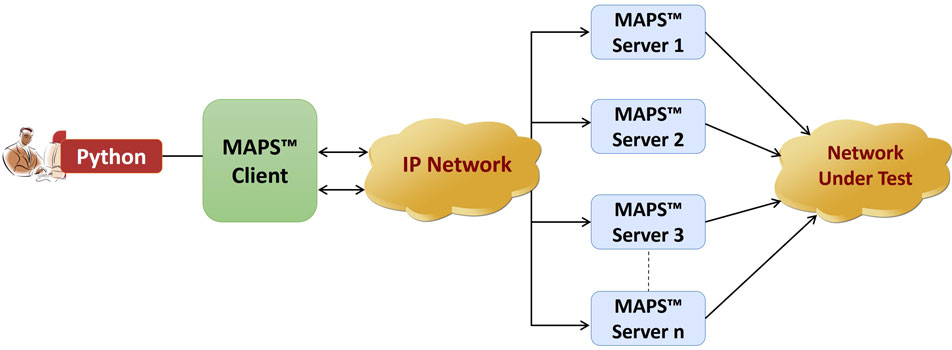
The MAPS™ 5G SBI can be configured as a CLI server application that supports Protocol control and interface procedure execution via instructions executed by command-line clients, such as Python. These clients can execute various functions remotely, such as initiating the testbed setup, loading scripts, profiles, call origination, termination, and traffic control etc.
The MAPS™ APIs allows for programmatic and automated control over all MAPS™ platforms. Each MAPS™ server can receive multiple client connections and offer independent execution to each client. Likewise, a single client can connect to multiple MAPS™ servers, including servers running different protocols, permitting complex cross-protocol test cases.
Client provides a simple scripting language, with programming facilities such as looping, procedures, and variables. The Client application includes a packaged library that enables communication with the Server from the Client environment. The advantage of such communication enables users to control MAPS™ by sending commands and receiving responses in a scripting language.
The following screenshots depicts transaction of API commands between the Python Client MAPS™ CLI Server.
Resources
Note: PCs which include GL hardware/software require Intel or AMD processors for compliance.
| Presentations |
|---|
| MAPS™ 5G N4 Interface Emulator - Presentation |
| MAPS™ 5G Network Emulation Suite - Presentation |
| PacketScan™ 5G Protocol Analyzer Presentation |
| Webinar |
|---|

|
